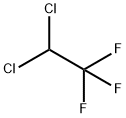1,1-Dichloro-2,2,2-trifluoroethane

- CAS No.
- 306-83-2
- Chemical Name:
- 1,1-Dichloro-2,2,2-trifluoroethane
- Synonyms
- r123;HCFC-123;F123;2,2-DICHLORO-1,1,1-TRIFLUOROETHANE;CF3CHCl2;hydrochlorofluorocarbon;R 123;CFC123;hfa123;FC-123
- CBNumber:
- CB5777280
- Molecular Formula:
- C2HCl2F3
- Molecular Weight:
- 152.93
- MOL File:
- 306-83-2.mol
- Modify Date:
- 2023/4/23 13:52:06
| Melting point | -107°C |
|---|---|
| Boiling point | 27.6°C |
| Density | 1,475 g/cm3 |
| vapor pressure | 93.456kPa at 25.62℃ |
| refractive index | 1.3290 |
| Flash point | 9℃ |
| storage temp. | 2-8°C |
| form | A liquid |
| Water Solubility | 2.1g/L at 25℃ |
| LogP | 2.17 at 20℃ |
| CAS DataBase Reference | 306-83-2(CAS DataBase Reference) |
| NIST Chemistry Reference | Ethane, 2,2-dichloro-1,1,1-trifluoro-(306-83-2) |
| EPA Substance Registry System | HCFC-123 (306-83-2) |
SAFETY
Risk and Safety Statements
| Symbol(GHS) |    GHS02,GHS06,GHS08 |
|||||||||
|---|---|---|---|---|---|---|---|---|---|---|
| Signal word | Danger | |||||||||
| Hazard statements | H225-H301+H311+H331-H370-H420 | |||||||||
| Precautionary statements | P210-P260-P280-P301+P310-P311 | |||||||||
| Hazard Codes | T,Xi,N | |||||||||
| Risk Statements | 23/24/25-39-39/23/24/25-59 | |||||||||
| Safety Statements | 36/37-45-59 | |||||||||
| RIDADR | 3163 | |||||||||
| WGK Germany | 1 | |||||||||
| Hazard Note | Irritant | |||||||||
| TSCA | T | |||||||||
| HazardClass | IRRITANT, GAS, OZONE DEPLETER | |||||||||
| Toxicity | LD50 skin in rabbit: > 2gm/kg | |||||||||
| NFPA 704 |
|
1,1-Dichloro-2,2,2-trifluoroethane Chemical Properties,Uses,Production
Chemical Properties
1,1-Dichloro-2,2,2-trifluoroethane has a light ethereal odor with poor warning properties.
Uses
HCFC 123 is an interim replacement for the CFCs and is scheduled for a production phase-out during the 2020s. Its main application is as a substitute for CFC 11 in centrifugal chillers used for air conditioning of large buildings. It is also used in smaller air-conditioning units, and may have applications in foam blowing, and firefighting and as a chemical intermediate.
General Description
Colorless nonflammable gas. Nearly odorless.
Reactivity Profile
1,1-Dichloro-2,2,2-trifluoroethane is chemically inert in many situations, but can react violently with strong reducing agents such as the very active metals and the active metals. They suffer oxidation with strong oxidizing agents and under extremes of temperature.
Health Hazard
HCFC-123 (2,2-dichloro-1,1,1-trifluoroethane) has evidenced significant human liver toxicity. A group of 17 workers suffered liver damage in a 1997 outbreak. They were involved in containerizing this liquid. HCFC-123 is chemically similar to halothane and has the same toxic metabolite. HCFC- 123 exposure also was implicated as the cause of liver disease in nine industrial workers who had repeated exposure because of a leaking airconditioning system in 1996; the refrigerant also contained HCFC-124. HCFC-124 and HCFC-125 are also structurally similar to halothane.
Safety Profile
Suspected carcinogen. Moderately toxic by inhalation. When heated to decomposition it emits very toxic fumes of Fand Cl-. See also CHLORINATED HYDROCARBONS, ALIPHATIC; and FLUORIDES.
Carcinogenicity
An inhalation toxicity/oncogenicity study was conducted with groups of 80 male and 80 female rats. This study was described earlier in this section. In addition to the effects on serum chemistry parameters and the retina, increases in benign tumors of the pancreas, testes, and liver were reported. As noted above, the survival in the HCFC 123–exposed animals was better than in the airexposed controls. These tumors tended to appear near the end of the study and generally were not considered to be the cause of death.
1,1-Dichloro-2,2,2-trifluoroethane Preparation Products And Raw materials
Raw materials
Preparation Products
306-83-2(1,1-Dichloro-2,2,2-trifluoroethane)Related Search:
1of4
chevron_right




